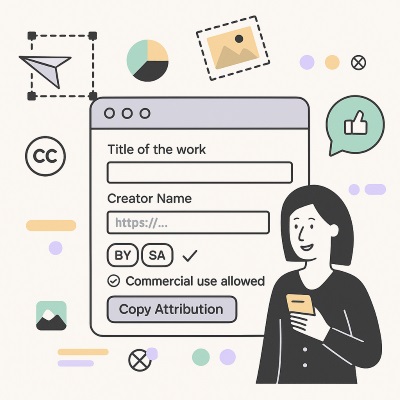Podcast Copyright Rules Checker: Which Music Rights You Need in 60 Seconds
Audiodrome is a royalty-free music platform designed specifically for content creators who need affordable, high-quality background music for videos, podcasts, social media, and commercial projects. Unlike subscription-only services, Audiodrome offers both free tracks and simple one-time licensing with full commercial rights, including DMCA-safe use on YouTube, Instagram, and TikTok. All music is original, professionally produced, and PRO-free, ensuring zero copyright claims. It’s ideal for YouTubers, freelancers, marketers, and anyone looking for budget-friendly audio that’s safe to monetize.
Many podcasters wing it with music and hope no one sends a takedown. This guide flips that gamble into a clear checklist. In a few minutes, you’ll map your music sources, spot red-flag uses, and run every episode through a rights pre-flight, not blind luck.
Podcast Music — Rights Needed Wizard
In ~50 seconds, see exactly which permissions you need, who to contact, scope to request, and feasibility flags.
Choose the closest primary use for the music.
Where is the track coming from?
Some sources restrict edits; this affects permissions.
Reels/Shorts or a full video episode on YouTube.
Educational guidance, not legal advice. Always check actual license terms.
Required Permissions
Embed This Tool on Your Website

Podcast copyright rules in plain language
Podcast copyright rules tell you who controls the music in your show, what you can safely do with it, and when you need a license before you hit publish.
Two distinct rights when you use music in a podcast
Most music in the world sits under copyright, even if it feels “old” or familiar. The first layer you meet is the composition, which is the song as written. That means the melody, chords, and lyrics, usually controlled by songwriters, composers, and the music publishers that represent them.

The second layer is the sound recording, also called the master. This is the specific recorded performance you hear in your headphones, not the idea of the song. A label, distributor, or the recording artist usually owns or controls this master and decides who can copy, sync, or monetize that particular version.

When you drop a song into your podcast, you usually touch both layers at the same time. Legal guides and music rights organizations explain that you often need permission for the composition and the recording separately, even if it is the same track. If you license only one layer and ignore the other, you still leave a gap that can trigger claims.
How different uses trigger different license types
Synchronization type uses happen when you line up music with visual content, even if your show is mainly audio. A video version of your podcast, teaser trailers, or social clips with waveform animations all count as pairing sound with pictures. In those cases, you normally clear rights for the song itself and, when relevant, the specific recording.

Mechanical type uses focus on copying and distributing the audio file that contains the music. Every time you offer downloads, on-demand streams, or archived podcast episodes, you create and send out new copies of that recording. In some countries, this triggers mechanical rights, which means you may need a license that covers reproduction, not just general “permission to use.”

Public performance rights come into play when listeners stream or hear your show in real time. This can happen through podcast platforms, radio simulcasts, or live broadcasts inside apps. Performance rights organizations often manage this layer for songwriters and publishers, and platforms sometimes handle it in the background, but you still need to understand that this is a separate right, not an optional extra.

Why podcast copyright rules aren’t a simple yes/no
Podcast copyright rules do not treat music like a single switch that you flip on or off. You need to know which rights apply, which layer they cover, and which type of use you plan. Once you see those pieces clearly, you can choose tracks and licenses that match your actual workflow instead of hoping a vague “OK to use” promise will protect you.
Why podcast music has multiple layers of rights
Podcast music rarely sits under a single simple permission, because each way you use a track can trigger a different set of rights, licenses, and expectations from the people who own the music.
How podcast workflows multiply risk
It might start as the main theme for your entire series, playing at the beginning and end of every episode. That single choice already repeats the same track everywhere. Then you might slide the same piece of music quietly under your voice as a background bed. It stays present through long segments, which means longer continuous use of that track.

In a sponsored segment or host-read ad, that song suddenly carries a commercial message. Now the track helps sell a product or service, which raises the licensing stakes. Later, you might cut the same music into trailers, audiograms, or short video clips you post on social platforms. Those pieces travel far beyond the original episode feed.

You might also capture music inside a live recording, for example, at a venue or event with background tracks playing. The recording locks in whatever music the microphones hear in the room.

Each of those uses can shift which rights you need and how broad they must be. A theme needs long-term coverage, a background bed needs many minutes per episode, and trailers often need cross-platform and sometimes paid media rights. Once you map every way the music appears, you can see why a simple one-line “OK for podcasts” promise often falls short.
Examples of how different uses change the rights you need
A label owned hit inside a sponsored segment usually means you clear at least two sets of rights. You talk to the publisher for the song itself and the label for the recording, then agree on whether the use counts as advertising, which territories you cover, how long the campaign runs, and what formats you use.

A public domain composition can look free at first glance, because the underlying song has moved out of copyright. You still need to check the specific recording you want to use, since many recordings of public domain works remain fully protected and owned by labels or performers. Treat the composition and the recording as separate checks before you rely on the phrase “public domain.”

A Creative Commons track can be a good option, but only if your use matches the exact license conditions. Some licenses allow commercial use and edits, others require non-commercial use or forbid modifications, and nearly all of them expect clear attribution to the creator. If your podcast includes sponsors, paid promotion, or heavy edits, you need to choose a license that explicitly allows those things.

How the Rights Needed Wizard reflects real-world complexity
The Rights Needed Wizard is built to mirror this messy reality rather than gloss over it. You tell the tool how you use the track in the show, where the music comes from, and how wide the campaign runs. In return, you get a specific rights map that ties uses to rights and sources, instead of a vague warning that leaves you guessing what to fix.
Common music sources and how rights differ
Most podcasters pull music from a few familiar places, and each source comes with its own rules, limits, and risks that you need to understand before you publish.
Indie artist tracks
When you work with an indie artist, the same person or small team may control both the song and the recording, which can make deals feel more flexible. That does not remove the need for a clear written agreement that says exactly what you can do. Your license should spell out media, term, territory, and, if ads, social clips, and video are allowed.

Label tracks / commercial releases
Label tracks and big commercial releases usually sit inside a more complex rights chain. A record label controls the master recording, and one or more publishers handle the composition, so you need permission from both sides. Once you add podcasts, ads, video versions, and cross-platform use, the negotiation often becomes slower and more expensive than most indie shows expect.

Public-domain compositions
Some older works slip into the public domain and no longer have copyright on the composition itself. That means you can use the underlying music freely, but many modern recordings of that same piece still carry full protection. You either clear rights for a specific recording or decide to commission or create your own performance.

Creative Commons (CC BY, CC0)
Creative Commons tracks can look like an easy win when budgets stay tight. CC BY licenses require you to credit the creator and follow every condition in the license, including rules about edits and commercial use. CC0 or “no rights reserved” offers very broad freedom, but it still depends on the uploader having the legal right to grant that waiver in the first place.

Commissioned originals
Commissioned music gives you the chance to shape rights around your podcast instead of squeezing your show into someone else’s template. With a clear contract, you decide if the work counts as work for hire, who owns the song and recording, and how you license that material back to the show. You can match term, territory, exclusivity, and ad rights to your long-term plans.

Royalty-free libraries
Royalty-free music libraries usually bundle rights in a simple license that covers both the recording and the underlying song. They often list approved uses like podcasts, YouTube, social clips, and sometimes ads in clear language on the track or plan page. You still need to read those terms closely to confirm your exact plans, including cross-posting, sponsorship,s and any wish for exclusivity.






How the Rights Needed Wizard works
The Podcast Music Rights Needed Wizard turns a messy rights puzzle into a short, guided interview. It focuses on how you actually use music in your show, not on abstract legal theory. You move through simple questions in everyday language and see how each answer shapes the rights you might need.

First, the Wizard asks about your use case. You choose if the track sits in your intro or outro, runs as a background bed, powers a trailer, supports a sponsored segment, appears in a live clip, comes from a guest, or lives in a custom commission. Then you tell it where the music comes from, such as a stock library, an indie artist, a label release, a public domain work, a Creative Commons track or a piece you commissioned.

Next, you describe how the music behaves inside your workflow. You say how much you plan to edit it, from no edits to simple trims or deeper remixes. You confirm if the audio stays inside the podcast feed or also travels into social posts and video, and you set the territory and duration, from a one-off campaign to long-term use with or without exclusivity goals.

Once you fill in those details, the Wizard pulls from a base rights profile for that type of source and shows if you usually need separate permissions for the master and the composition, and who controls each layer. It then adjusts that picture for your use case and editing plans, and turns everything into a clear scope summary with media, term, territory, editing rights, and exclusivity.
As a final step, it flags common problems such as impossible exclusivity in stock libraries, missing social or ad rights, and uncertain public domain or Creative Commons history, so you end with a practical checklist you can use before you contact rights holders, sign a license, or lock your final mix.
Inputs explained (what each dropdown actually changes)
Each dropdown in the Rights Needed Wizard adjusts how the tool views risk, scope, and who you need to talk to. Instead of hiding these details in legal language, the inputs surface them in plain terms so you can see how each choice affects your music rights.
Use case
The Use case dropdown captures what the music actually does inside your show. It covers roles like intro or outro theme, constant background bed, trailer or teaser, sponsored or host read segment, live recording clip, guest supplied track, or commissioned original. The tool uses this to decide when to treat your use as advertising, when to think across an entire series or platform set, and when to lock in composition rights for things like live captures.

Music origin
The Music origin dropdown tells the wizard where the track comes from and which rights structure you will probably face. It distinguishes stock and royalty-free libraries, indie artist or label catalog, public domain compositions, Creative Commons tracks, and custom commissions. With that context, it can mark master and composition as clearly needed, clearly not needed, or dependent on contract terms, so you know which layer to investigate.

Editing
The Editing dropdown describes how far you plan to shape the music in production. If you play the track straight, the tool treats it as the simplest use, while trims, loops, fades, ducking, and basic EQ show a more typical podcast workflow. When you choose remix or alternate mix, the wizard adds reminders to confirm derivative rights and may flag extra friction for label or indie catalog material.

Cross-post to socials/video
The Cross post to socials or video choice tells the wizard if your use stays inside audio or moves into full audiovisual territory. A yes here signals likely use on YouTube, Shorts, Reels, TikTok, or video episodes, which usually involves sync-style rights and platform rules. The tool responds by expanding the scope label to Podcast plus Social or Video, reminding you to check that your license clearly covers those surfaces and warning you when a source looks audio only.

Territory
The Territory dropdown defines where your permission needs to work, rather than where you personally sit. Domestic covers a single country or primary market, regional covers grouped markets such as Europe or North America, and worldwide assumes global reach through common podcast apps. The wizard does not calculate price, but it pins territory into your scope summary so you remember to name it in emails and agreements instead of leaving it vague.

Duration
The Duration dropdown sets how long you want to rely on the rights you secure. A short one-off window fits a limited campaign or promo, a one-year span matches many seasonal marketing plans, and a perpetual option matches evergreen episodes that stay in your feed indefinitely. Since old podcast episodes rarely disappear, the tool leans on duration as a key reminder and highlights ambitious combinations, such as perpetual use plus exclusivity, as items that need real budget and careful clearance.

Exclusivity
The Exclusivity dropdown shows how much control you want over who else can use the same track. No exclusivity fits most stock, library, and off-the-shelf licenses, while category exclusive use reserves the track for your niche, and full exclusivity aims to keep everyone else away. The wizard links this back to origin and duration, warning you that exclusivity is rare for stock catalogs and that any long-term exclusive plan needs clear ownership, documentation, and realistic expectations.

Outputs explained (reading your rights map)
When you click “Show my required permissions”, the tool opens a pop-up that turns all your answers into a simple rights map you can actually read and use.
The Rights Map section shows which layers of rights you need. It explains if you need master rights for the recording and how that connects to your planned use, and it shows how composition rights for the song flow from your chosen source. Together, these lines mirror podcast copyright rules by separating recording and song into two clear permission tracks.

The Who to contact line turns that map into real next steps. It points you toward a library licensing team if you use stock, an artist or label, and possibly a songwriter or publisher if you use indie or commercial tracks, or a recording owner, composer, or your own contract if you work with public domain or commissioned music. That way, you reach the people who can actually say yes, instead of sending vague messages that ask if you may use a track in your show.

Scope reminders gather the moving parts that usually get lost in long email threads. The pop-up repeats your media mix, term, territory, editing plans, ad, and sponsor context, and any exclusivity goals in one short block of text. You can almost lift that paragraph directly into a license request or draft agreement, which keeps everyone talking about the same concrete scope.

Feasibility flags sit next to this summary and act like early warning lights. They highlight clashes between exclusivity wishes and stock catalog rules, missing social or video rights when you plan to cross-post, tight rules around sponsored use, extra care for remixes, and the need to verify public domain or Creative Commons sources. The idea is to uncover these pressure points before you sign anything or publish an episode, so you avoid surprises from claims and takedowns later.
Step-by-step: run a rights pre-flight
Start by filling in the wizard with your real production plan, not a best-case wish. Choose the use case that matches how the track sits in your episode and pick the origin that reflects where you actually sourced it. Then set cross-posting, territory, duration, and exclusivity to mirror the campaign you intend to run.
Next, read the rights map together with the Who to contact line. Check whether you need master rights, composition rights, or both, and note which party controls each layer. If the tool shows Maybe or Depends, treat that as a signal to pause and dig into contracts, platform terms, or direct conversations.
Then turn the scope reminders into your email or contract skeleton. Copy the media, term, territory, editing plans, ad context, and exclusivity wishes into your outreach, even if you only write to a single artist or library. This keeps everyone focused on the same concrete use instead of vague talk about “using a song in a podcast.”
Before you lock anything in, look closely at the feasibility flags. If you see a mix of global territory, perpetual use, heavy remixing, and full exclusivity on a high-profile track with almost no budget, adjust your expectations or your music choice. It is far easier to tweak the scope at this stage than to renegotiate or replace tracks later.
Used this way, the rights pre-flight turns podcast copyright rules into a repeatable checklist. You answer practical questions, translate them into clear rights asks, and move forward with a documented plan. Over time, this habit makes each new season or campaign safer, faster, and easier to clear.
Podcast Music — Rights Needed Wizard
In ~50 seconds, see which permissions you need, who to contact, scope to request, and feasibility flags.
Embed This Tool on Your Website

Practical examples for real shows
These examples demonstrate how the same tool responds to different real-world podcast setups, helping you envision what your own show might trigger.
Stock library track as a background bed
A host uses a stock library track as a background bed in episodes. The editor trims, loops, and ducks the music, then releases the show as audio and on YouTube. The team wants worldwide, perpetual use with no exclusivity and no need to swap tracks later.
A setup like this leads the wizard to treat the library license as covering master and composition rights for podcast use if the terms allow it. It still pushes you to read the fine print for ads and YouTube coverage. The scope summary locks in media, territory, and duration so you can quote them in emails.
Indie artist song in a sponsored segment
In this case, a show runs an indie artist’s song under a paid sponsor read. The editor does light trimming and balancing, then cuts short promo clips for Instagram and TikTok. The campaign runs for at least a year in several markets, and the sponsor wants category-exclusive use.
Here, the wizard shows that you need separate master and composition rights, even if the same artist controls both layers. It steers you toward a written agreement that names the podcast and social use, ad context, territory, term, and exclusivity. Feasibility notes remind you that this looks like a custom license, not a casual yes in a message thread.
Public-domain composition recorded in-house
Another show picks a public domain hymn or classical piece as its main intro and outro. The team records a new performance in its own studio and does basic trimming and looping. The plan covers worldwide, perpetual use with no exclusivity and a stable sonic identity for the feed.
When you enter this, the wizard shows no composition license needed in your territory if the work is truly in the public domain. It marks master rights as owned by your production because you created the recording and points you back to any performer agreement. Feasibility notes still prompt you to confirm that the underlying work and any reference recordings are indeed public domain or clearly documented as CC0.
FAQs
These questions come straight from real podcast communities, but the answers focus on general rules so you can plan safer music use for your own show.
Can I sing a few lines of a popular song on my podcast?

If you sing a recognizable song, you still use the underlying composition, even without the original recording. That usually needs permission from whoever controls the song, such as a publisher or songwriter. Short or “just a few lines” does not automatically make it free to use.
How do podcast intro songs and copyright work if I use a site like Artlist?

Intro music usually repeats across many episodes, so your license needs to cover long-term use for your whole series. With stock or subscription libraries, check that your specific plan covers podcast intros, monetized shows, and any YouTube or video versions. Always keep proof of your license, including account details and track links.
Is it true that background music under my voice avoids copyright issues?

No, volume does not change copyright. If you play recorded music in the background, you still use both the recording and the song, even when the voice sits on top. You should assume normal licensing rules apply unless your license or the rightsholder clearly says otherwise.
Can I drop in 10–20 second clips from songs or movie trailers I found on YouTube?

Using short clips from copyrighted songs, trailers, or interviews can still infringe if you do not have permission. There is no guaranteed “safe” number of seconds for podcasts. Unless the material is clearly public domain or licensed for this use, you should treat those clips as needing proper clearance.
We have permission from a friend to use their song; can platforms still flag it?

Yes, platforms can still flag content because automated systems look at audio fingerprints, not your private agreement. Your friend or their distributor may need to allowlist your show, remove conflicting claims, or respond to disputes. Keep written proof of permission so you can show it if a claim appears.
Putting podcast music rights on autopilot
Podcast copyright rules stay complicated, but your process does not have to. Run each idea, track, and campaign through the Rights Needed Wizard and keep the rights map with your show notes. Over time, you build a repeatable pre-flight that protects your archive as well as new episodes.

At Audiodrome, we create interactive tools designed to simplify music licensing and monetization. They help creators, agencies, and businesses avoid common mistakes, save time, and stay compliant while building content that earns fairly across platforms.
Each tool translates complex rules into clear, practical guidance. Our goal is to give you confidence before publishing, ensuring your projects are protected, professional, and ready to succeed in a fast-changing media landscape.













